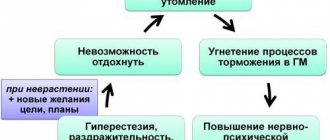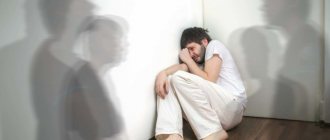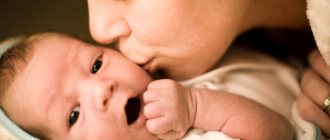Affective-respiratory syndrome in children under 5 years of age is detected in 5 percent of cases. It occurs quite rarely, but every year such cases become more frequent. The disease is diagnosed by doctors if, during emotional stress, the child exhibits symptoms of apnea: inability to breathe for 1 minute. Apnea is often accompanied by convulsions and short-term fainting.
At such moments, it is difficult for the brain to cope with difficulties; there is a lack of oxygen, which entails unpleasant consequences for the health of the nervous system. These reasons lead to the fact that global health care compulsorily advises children with this disease to undergo regular examinations by doctors, even if the disease is mild.
General information
Affective-respiratory attacks are attacks of spasmodic crying or severe anxiety of a child with “sunset” in conditions of a negative emotional reaction. They are most often observed in children from six months to one and a half years and manifest themselves in the form of episodic short-term breath holding ( apnea ), which can be accompanied by apneic convulsions and loss of consciousness .
Despite the frightening manifestations, seizures are not life-threatening for the child, and subsequently, upon reaching the age of three to five, they disappear spontaneously, and therefore do not require treatment. No more than 5% of the population suffers from affective-respiratory attacks, regardless of the gender of the child. A positive family history was identified in 25% of cases.
Why do seizures occur?
- Excessive sensitivity, psychological imbalance due to characteristics of the nervous system: due to temperament or characteristics in the visceral nervous system;
- Legacy reason. For example, increased excitability is hereditary. According to statistics, 25 percent of children with a similar syndrome are born in families where this disease has already occurred;
- If a child is brought up in a not the best psychological environment, when parents often quarrel and allow frequent conflict situations. All this affects the child’s psyche.
Age norms
Affective respiratory syndrome is not often diagnosed in young children. As you grow older, it is also difficult to determine the disease, because if a child cries, he is simply communicating with the world (he simply does not know how to do otherwise), so it is fundamentally wrong to consider this a symptom. Being already at an older and more conscious age, children consider crying as a way to achieve what they want: to get a toy, candy or entertainment.
The ability to control emotions appears in a child between the ages of 4 and 5 years. It is at this age that affective-respiratory syndrome is detected least often. If children are unable to control their emotions, this indicates a potential symptom of the disease.
Pathogenesis
Affective-respiratory manifestations occur in conditions of increased nervous reflex excitability and a tendency to hysteroid reactions. When a child cries or screams, a spasm of the larynx occurs and breath holding may occur during the inhalation stage, which causes pallor or cyanosis of both the skin and mucous membranes of the mouth. The result of developing hypoxia is a disruption of the regulation of the autonomic nervous system, the development of tonic convulsions, and short-term fainting, which last from several seconds to several minutes.
Treatment
There is no definite treatment in this case, especially since it is not fatal and after 3-4 years it all goes away. It is very important for parents to be informed so as not to be scared and not cause trouble for their child because of this. There are, of course, two directions for treatment - medicinal and non-medicinal. Moreover, the second method is the main one. The family needs to consult with a psychologist who will give valuable recommendations on raising the child, actions during the child’s attack and preventing its reoccurrence, as well as establishing mutual understanding in the family.
Only when parents cannot help the child themselves, it is necessary to use medications whose main function is to treat increased excitability and neuropathy. Treatment for a child should be selected only by a neurologist, and there is no need to listen to the advice of a pharmacist at the pharmacy. Medicines are selected individually for each child.
Classification
Depending on the pathogenesis and completeness of the clinical picture, effective respiratory attacks in children are of different types:
- The usual type is a classic manifestation of an affective-respiratory attack - holding your breath while inhaling, which occurs as a result of injury or frustration - the inability to satisfy certain needs, outwardly resembles laryngospasm .
- Blue type - neurotic or neurosis-like attacks are the result of anger, frustration, and sometimes pain; while crying, the child may exhale forcibly, holding his breath occurs, which causes vegetative-vascular disorders: cyanosis (blueness of the skin), loss of muscle tone, dilated pupils and syncope, most often children regain consciousness on their own or fall asleep for several hours; This type of affective-respiratory seizures is characterized by the absence of a postictal phase and a normal EEG.
- Pale or white type (affective-respiratory syncopation) - unlike the blue type, it causes pallor of the skin, asystole and occurs during crying or its absence; also, with a normal EEG, it leads to fainting and does not have a post-ictal phase.
- Affectively provoked epileptic seizures or the so-called complicated type are considered a more pronounced and severe form of the types of seizures described above, which begin as “blue” or “pale” and turn into a pseudo-epileptic seizure; the EEG outside of seizures is usually normal.
Affective-respiratory syndrome: ICD, classification
- Easy stage. Lasts about 15 seconds, the child is not able to breathe normally. There is no danger to the brain, but you should still consult a neurologist.
- "Pale" stage. Occurs due to external factors. For example, due to pain, a blow, an injection or a fall. During attacks, the child becomes pale and may faint. Affective symptoms such as crying or screaming may not occur.
- "Blue" stage. The catalyst for attacks is the environment: stress, pressure, strong excitement. Symptoms during this stage are: the skin becomes blue, apnea lasts about 20 seconds, and in rare cases, seizures occur.
- Complicated affective-respiratory syndrome. Often manifests itself in infants. This stage differs from previous ones in its complexity and duration of attacks. The syndrome manifests itself not only due to temperament or characteristic features, but also due to problems with the central nervous system.
Causes
As a manifestation of a heightened emotional state, affective-respiratory seizures are the earliest manifestation of hysterical paroxysms and usually occur in response to:
- feelings of disappointment, anger, fear, joy and other strong emotional shocks;
- force feeding;
- severe pain, for example, when falling from a height, “pale syncopation” occurs as a result of reflex asystole, which is especially dangerous for children with heart disease.
neurasthenia and neurosis , overprotection, vitamin D metabolism disorders, hypocalcemia and hypohemoglobinemia can contribute to the development of attacks of abnormal breathing .
Prognosis and treatment of affective-respiratory syndrome
What complications can there be:
- Epilepsy;
- Hypoxia;
- Memory problems;
- Confusion;
- Disorder in mental actions;
- Speech problems.
To reduce the number and complexity of attacks in children, experienced neurologists advise seeing a psychotherapist and regularly undergoing light rehabilitation in clinics:
- Sand therapy;
- Microcurrent;
- Sensory integration;
- Neuropsychological correction.
If even unobvious symptoms of such a disorder occur, you should contact a specialist in order to prevent the development of the disease. You need to understand that the first stage can develop with age, which will greatly complicate treatment. If you are constantly monitored by doctors and follow all recommendations, you can live calmly with affective-respiratory syndrome.
Symptoms
Depending on the type of affective-respiratory seizure, the symptoms may differ, but in general they consist of the following reactions:
- respiratory arrest caused by screaming or crying;
- turning blue or pale;
- severe hypotension (the child goes limp);
- short-term loss of consciousness, which may be followed by several hours of sleep;
- involuntary urination;
- the occurrence of seizures.
If affective-respiratory paroxysms are not stopped in time, then subsequently the child may experience hypoxia:
- short-term loss of consciousness;
- clonic-tonic or tonic convulsions ;
- post-attack lethargy and drowsiness;
- enuresis.
Komarovsky about affective-respiratory attacks in children
The best person to explain what an affective-respiratory attack is is Dr. Komarovsky, popular and beloved by all mothers. In his television program “Ask Dr. Komarovsky,” he says that a seizure usually begins with a situation where a child is under the influence of some unpleasant external factors, for example, fear or refusal to do what he wanted, as well as pain and fright.
The child begins to cry hysterically, and his breathing stops for some time - so to speak, the child “breaks down crying.” In medical science, this condition is called an affective-respiratory attack, that is, in a state of uncontrollable negative strong emotion - in a state of passion , a sudden stop in breathing occurs.
As a rule, these paroxysms can begin after 6 months of life and, without any treatment, end sooner or later. Usually at a maximum of 4, extremely rarely - at 4.5-5 years, affective-respiratory attacks outgrow and they are a certain stage in the development of the nervous system. They, most often, do not need any treatment, although it is recommended to show the child to a doctor, because a situation can still be dangerous to health when:
- stopping breathing lasts more than a minute, this happens extremely rarely;
- in a child, severe reflex anoxic seizures with breathing stops for more than 30 seconds occur more often than 2-3 times a week.
What to do in case of affective-respiratory attacks?
The main task is to prevent the child from falling, and therefore from being injured, so it is best to calmly approach the baby, hug him, thereby preventing a fall. It is important not to make the parent himself hysterical and not to change his face. In addition, you can put something cold on the child's face or even wet your hand with cold water and splash it on the child. The main thing is to treat this calmly; the child always outgrows it if the syndrome is not a reason for personal hysterics and panic among parents and relatives.
If the seizure was provoked by the failure to fulfill the child’s wishes, then you need to understand that after the child has come to his senses, you cannot succumb to provocation - do not do what the baby wanted, do not discuss what happened and do not punish. It’s good if the mother or father pretends that nothing happened. Otherwise, you are suggesting the wrong mechanism for solving problems and contributing to the development of neurasthenia in the future.
Respiratory-affective attacks
Authors : Bitterlich L. R.
Affective-respiratory attacks (attacks of breath holding) are the earliest manifestation of fainting or hysterical attacks. The word "affect" means a strong, poorly controlled emotion. “Respiratory” is something that has to do with the respiratory system. Attacks usually appear at the end of the first year of life and can continue until 2-3 years of age. Although holding their breath may seem deliberate, children usually do not do it on purpose. This is simply a reflex that occurs when a crying child forcefully exhales almost all the air from his lungs. At this moment he falls silent, his mouth is open, but not a single sound comes from it. Most often, these breath-holding episodes do not last more than 30-60 seconds and pass after the child catches his breath and starts screaming again.
Sometimes affective-respiratory attacks can be divided into 2 types - “blue” and “pale”.
“Pale” affective-respiratory attacks are most often a reaction to pain from a fall or an injection. When you try to feel and count the pulse during such an attack, it disappears for a few seconds. “Pale” affective-respiratory attacks, according to the mechanism of development, are close to fainting. Subsequently, some children with such attacks (paroxysms) develop fainting states.
However, most often affective-respiratory attacks develop according to the “blue” type. They are an expression of dissatisfaction, unfulfilled desire, anger. If you refuse to fulfill his demands, achieve what you want, or attract attention, the child begins to cry and scream. Intermittent deep breathing stops on inhalation, and slight cyanosis appears. In mild cases, breathing is restored within a few seconds and the child’s condition returns to normal. Such attacks are superficially similar to laryngospasm - a spasm of the muscles of the larynx. Sometimes the attack drags on somewhat, and either a sharp decrease in muscle tone develops - the child goes limp in the mother’s arms, or tonic muscle tension occurs and the child arches.
Affective-respiratory attacks are observed in children who are excitable, irritable, and capricious. They are a type of hysterical attack. More “ordinary” hysteria in young children is characterized by a primitive motor reaction of protest: when desires are not fulfilled, the child falls to the floor in order to achieve his goal: he randomly hits the floor with his arms and legs, screams, cries and demonstrates his indignation and rage in every possible way. This “motor storm” of protest reveals some features of hysterical attacks of older children.
After 3-4 years of age, a child with breath-holding or hysterical reactions may continue to have hysterical attacks or have other character problems. However, there are ways that can help you prevent the dreaded two-year-olds from turning into the dreaded twelve-year-olds.
Principles of proper education of a small child with respiratory-affective and hysterical attacks. Seizure prevention
Attacks of irritation are quite normal for other children, and indeed for people of all ages. We all experience bouts of irritation and rage. We never get rid of them completely. However, as adults, we try to be more restrained when expressing our dissatisfaction. Two-year-old children are more frank and direct. They are simply venting their rage.
Your role as parents of children with hysterical and respiratory-affective attacks is to teach children to control their rage, to help them master the ability to restrain themselves.
In the formation and maintenance of paroxysms, the incorrect attitude of parents towards the child and his reactions sometimes plays a certain role. If a child is protected in every possible way from the slightest upset - everything is allowed to him and all his demands are fulfilled - so long as the child does not get upset - then the consequences of such upbringing for the child’s character can ruin his entire future life. In addition, with such improper upbringing, children with attacks of breath holding may develop hysterical attacks.
Proper upbringing in all cases requires a unified attitude of all family members towards the child - so that he does not use family disagreements to satisfy all his desires. It is not advisable to overprotect your child. It is advisable to place the child in preschool institutions (nursery, kindergarten), where attacks usually do not recur. If the appearance of affective-respiratory attacks was a reaction to placement in a nursery or kindergarten, on the contrary, it is necessary to temporarily remove the child from the children's group and re-assign him there only after appropriate preparation with the help of an experienced pediatric neurologist.
The reluctance to follow the child’s lead does not exclude the use of some “flexible” psychological techniques to prevent attacks:
1. Anticipate and avoid flare-ups.
Children are more likely to burst into crying and screaming when they are tired, hungry or feel rushed. If you can anticipate such moments in advance, you will be able to circumvent them. You can, for example, avoid the hassle of waiting in line at the cashier at the grocery store by simply not shopping when your child is hungry. A child who gets irritated during the rush to get to nursery during the morning rush hour, when parents are also going to work and an older sibling is going to school, should get up half an hour earlier or, conversely, later - when the house is calmer . Recognize difficult moments in your child's life and you will be able to prevent attacks of irritation.
2. Switch from the stop command to the forward command.
Young children are more likely to respond to a parent's request to do something, called "go" commands, than to listen to a request to stop doing something. So if your child is screaming and crying, ask him to come to you instead of telling him to stop screaming. In this case, he will be more willing to fulfill the request.
3. Tell the child his emotional state.
A two-year-old child may be unable to verbalize (or simply acknowledge) his feelings of rage. In order for him to control his emotions, you should give them a specific name. Without making a judgment about his emotions, try to reflect the feelings the child is experiencing, for example: “Maybe you are angry because you didn’t get the cake.” Then make it clear to him that despite his feelings, there are certain limits to his behavior. Tell him, “Even though you are angry, you should not yell and scream in the store.” This will help the child understand that there are certain situations in which such behavior is not acceptable.
4. Tell your child the truth about consequences.
When talking to young children, it is often helpful to explain the consequences of their behavior. Explain everything very simply: “You have no control over your behavior and we will not allow it. If you continue, you will have to go to your room.”
Convulsions during respiratory-affective attacks
When a child’s consciousness is impaired during the most severe and prolonged affective-respiratory attacks, the attack may be accompanied by convulsions. The cramps are tonic - muscle tension is noted - the body seems to become stiff, sometimes arches. Less commonly, during respiratory-affective attacks, clonic convulsions are observed - in the form of twitching. Clonic convulsions are less common and are then usually observed against the background of tonic convulsions (tonic-clonic convulsions). Cramps may be accompanied by involuntary urination. After convulsions, breathing resumes.
In the presence of seizures, difficulties may arise in the differential diagnosis of respiratory-affective paroxysms with epileptic seizures. In addition, in a certain percentage of cases, children with affective-respiratory convulsions may subsequently develop epileptic paroxysms (attacks). Some neurological diseases can also cause such respiratory affective attacks. In connection with all these reasons, to clarify the nature of paroxysms and prescribe the correct treatment, every child with respiratory-affective attacks should be examined by an experienced pediatric neurologist.
What to do during a breath-holding attack
If you are one of those parents whose child holds their breath in a fit of rage, be sure to take a deep breath yourself and then remember this: Holding your breath almost never causes harm.
During an affective-respiratory attack, you can use any influence (blow on the child, pat the cheeks, tickle, etc.) to promote the reflex restoration of breathing.
Intervene early. It is much easier to stop a rage attack when it has just begun than when it is in full swing. Young children can often be distracted. Get them interested in something, say a toy or other form of entertainment. Even such a simple attempt as tickling sometimes brings results.
If the attack is prolonged and accompanied by prolonged general relaxation or convulsions, place the child on a flat surface and turn his head to the sides so that he does not suffocate if he vomits. Read in detail my recommendations “HOW TO HELP DURING AN ATTACK OF SEIZURES OR CHANGES IN CONSCIOUSNESS”
After an attack, reassure and reassure your child if he does not understand what happened. Reemphasize the need for good behavior. Don't back down just because you want to avoid repeat breath-holding episodes.








